© ROOT-NATION.com - Use of content is permitted with a backlink.
We’ve seen a lot of great games this year, many of them already in the race to become the new GOTY. But no matter how good were these exclusive masterpieces from Sony or multiplatform games from Japan, not one of them could compete with The Legend of Zelda: Breath of the Wild – a flagship title for Nintendo Switch console. This game had us hyped for many years, and to finally be able to play it was phenomenal. With such name as The Legend of Zelda, nobody expected anything else. But nobody really anticipated it to live up to the hype either, with critics calling it the best game of all time. What happened? How is it that good? Is it that good?
There were a lot of reasons not to expect greatness from The Legend of Zelda: Breath of the Wild. Many gamers were skeptical – even the most devoted ones. I can’t blame them: the game looked like a desperate attempt to copy popular trends, but with a huge delay. It looked, quite honestly, silly: to copy a popular, but already dated The Elder Scrolls V: Skyrim seemed like an uninspired idea from the developers, who once created trends themselves. To add to that, The Legend of Zelda: Breath of the Wild was long in the making – too long, in fact, for it not to become suspicious. We all know that often-delayed games frequently become disasters.
But we shouldn’t have underestimated Nintendo. Sure, they had a lot of setbacks in the last couple of years, but rarely did they disappoint in terms of actual games. Even the failed Wii U was a home to some of the most innovative and creative games they have ever made. The Japanese strive for perfection and it shows.
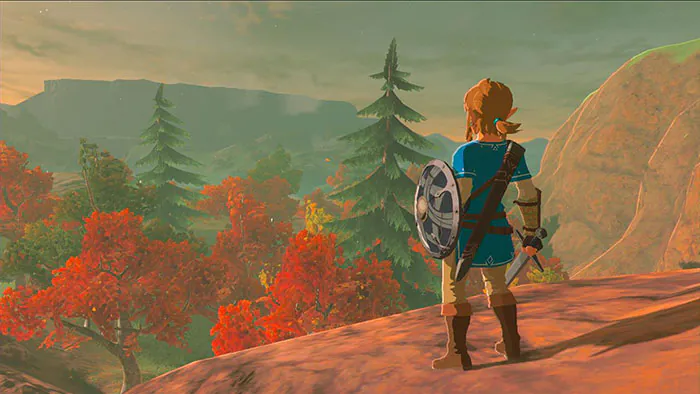
Anyone familiar with Link’s adventures understand what to expect from The Legend of Zelda: Breath of the Wild. Those unlucky who never got to play these legendary games might not understand what all this fuss is about. There are still a lot of people who never got around to owning a Nintendo system. I have good news for you – this game is perfect for you.
But then again, for those unacquainted with the series: The Legend of Zelda is an old gaming series with a recurring motive. Link (yes, the hero’s name is Link, NOT Zelda) goes on adventures over and over again, in different times and in different places. Mostly he has to save princess Zelda and fight evil Ganon. It’s hard to grasp all these different timelines, but, thankfully, the canon is not important here: Breath of the Wild is easy to understand even for newbies.
The genre is fantasy action RPG with a lot of puzzles. Historically, the series known a lot of (sometimes bizarre) spinoffs – some of them platformers or isometric RPGs. Nintendo’s home consoles usually got pretty standard 3D games with a couple of unique features. On paper, The Legend of Zelda: Breath of the Wild looks like Skyrim of The Witcher, but it really is a very different games, albeit with a few obvious influences. It’s easy to compare these games and see the differences between the Western and Eastern developers: often there’s no quest marker on the map, and most of the characters are “mute” speaking only via subtitles. Some scenes have voice actors, which is a first for the series. The quality of these actors is a different topic for discussion.
Before we delve into the game itself, let’s talk about the platform. Casual gamer might think The Legend of Zelda: Breath of the Wild is an exclusive game for the Switch, but it’s false – the game has also been released for Wii U. Nintendo has done something like that in the past – and also with a Zelda game. Mostly, these games are identical, and even if you by any chance have a Wii U, there’s no reason to rush and buy the new console. In fact, Nintendo has done everything possible to make these games similar, which resulted in Wii U version being slightly inferior to the one that had initially been developed. How so?
The game has no gamepad functionality whatsoever. Sure, a lot of Wii U games lacked any second screen features, but we’ve actually seen the gamepad in action with The Legend of Zelda: Breath of the Wild! In fact, it seemed perfect, to have a map and the inventory always open. The game might be even better that way. But the developers didn’t want the version for the older console to be in any way better and have cut out this functionality, pretending that they were doing us a favor.
Otherwise there are no differences. Switch runs it a bit better with little to no hiccups in portable mode and some FPS slowdowns in TV mode. While Wii U outputs 720p, the Switch has an upper hand with 900p in TV mode and 720p in handheld mode. Both versions run it at 30 frames per second.
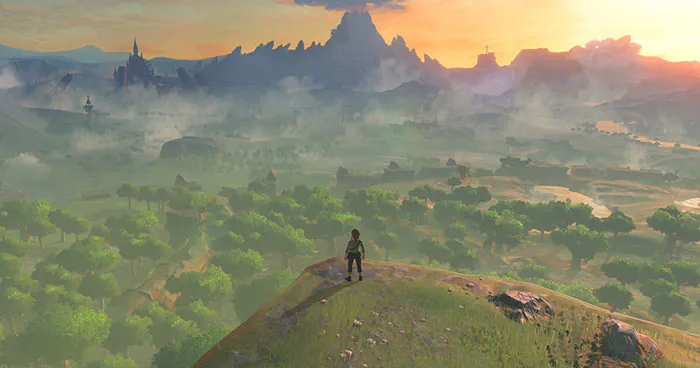
There are lot of reasons as to why The Legend of Zelda: Breath of the Wild is considered by many as a modern classic and even the best game ever. For example, many of us were overjoyed to see the disappearance of Link’s companions who acted as needless walking and talking tutorials – much like the dreaded Clippy of the past. These were the bane of most modern 3D Zeldas and to see them gone is so good. In fact, tutorials and handholding segments are also nowhere to see. We don’t have to look for special weapons – we don’t have to do anything.
Yes, it is the true open world game. It’s strange to say like it’s a big deal in 2017, but it is. Sure, there are tons of huge open world games out there, but none feel as open as The Legend of Zelda. They had space, but lacked freedom. Here you are as free as you’ve ever been in a videogame. Go anywhere, do anything. No problems with the world’s size either – it’s reported to be even bigger than Skyrim’s. Its immensity is more obvious when you have no map or a guide. That’s the thing about Breath of the Wild – it respects the player. It is the most fundamental and old-school way to make games. It’s like they’re saying: “We know it’s hard, but you’re no loser, right? You’ll figure it out”.
The story in The Legend of Zelda: Breath of the Wild is told through flashbacks, which allows us not to worry about continuity. No matter what shrine you visit first, you won’t miss anything. What a neat way to tell a cohesive story without compromising our freedom.
The story itself is, as usual, pretty simple, but you can skip this block of text if you are sensitive to spoilers. This is a tale about Link and his quest to save the princess – nothing new here. A hundred years ago a great battle took place all over Hyrule, and even the greatest of warriors – you included – couldn’t stop Calamity Ganon from overtaking the kingdom and claiming the castle. Since then, only Zelda somehow continued to fight Ganon, while Link took a nap for a century. But now he’s awake and ready for action. One problem – he doesn’t remember anything. A convenient, if not clichéd, plot device to ease us into this new world.
Even with the fate of the world resting, as always, in your hands, there are a lot of side activities here. Mostly you’ll be searching for Shrines, which are kinda like small dungeons with different puzzles or challenges. Some of them will test your intelligence, some will force you to retreat and find better weaponry. There are about 100 of those in the game. Four completed shrines allow you to get either a heart container or a stamina container. Once again, an ingenious way to design game progression. No mindless grind and no skill upgrading – this game is lot like any other. You might think that these dungeons are just like in the previous games, where puzzles have always been an important aspect of the gameplay, but that’s not exactly true.
Unlike before, puzzles here do not require you to beat them in a specific way it was designed because here everything is based on a physical engine. The engine allows players to find new inventive – and sometimes game breaking – ways to pass challenges in a matter of seconds. Let me tell you, to outsmart the game – and the designers – like that is always a great feeling. Most Shrines have hidden (and not so hidden) treasure chests in them, so don’t rush to get that Spirit Orb – otherwise you’ll have to do it all again.
There are other things to do as well. You can try and find as many Korok seeds as possible – there are hundreds of them hidden all over the world. You should also look for towers which allow you to open a section of the map – a sudden addition from the Far Cry game series. You can discover new villages and stables or find new entries for your ever-growing compendium. All of this will take hours and hours. The story can be completely ignored for the most of the time. It’s ironic: we feared that Nintendo will try to emulate other games, but they outdone everyone and completely reinvented the open world genre.
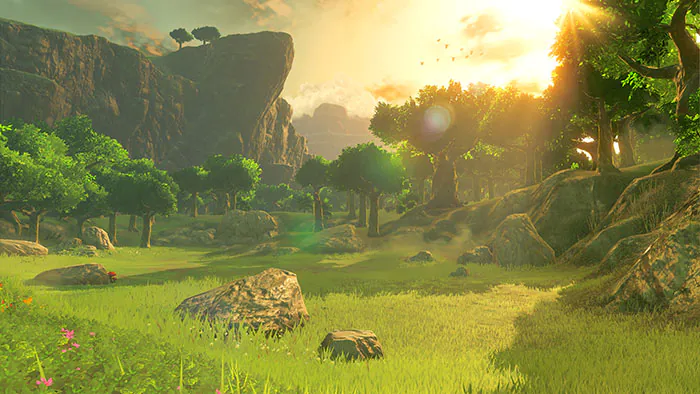
The game is hard. It’s not brutal, but it needs you to get it. It has its own logic – the world here works in a specific way. When it rains, the rocks will get slippery and you wouldn’t be able to climb – but the monsters won’t hear you. A lot of things here are not explained at all, which is weird but hey – that’s what the Internet’s for.
Every encounter with a monster can be fatal. Even low-level bokoblins can one-shot you if they feel like it. You have to stay vigilant even in the tritest of situations. The game forces you to think tactically and consider every new move. You have to get creative in The Legend of Zelda: Breath of the Wild, because only one tactic won’t cut it. Every weapon is brittle and breaks after a couple of hits. Found a nice-looking sword? Too bad – you can either hang in on the wall or loose it in a fight. There were times when I wanted to look as dashing as possible which prompted me to have one sword only for showing off. It is silly, yes, but I hate the way my Link looks with a wooden bat, sorry!
In order to withstand a tough fight, it is advisable to get ready beforehand. There are no health potions per se, but you can heal yourself with a healthy snack, which you should prepare in advance. Making meals is vital, but the game doesn’t teach you how to do it. Odd, but consistent with the way they handle tutorials in this game. There’s no cooking book either, so prepare to experiment a lot. Yeah, you’ll make a lot of inedible garbage, but trying new things is fun. I really liked this addition. Lazy players won’t find any shortcuts either – merchants rarely sell anything helpful in that capacity. There are potions in this game, but, once again, you have to make – or cook – them yourself.
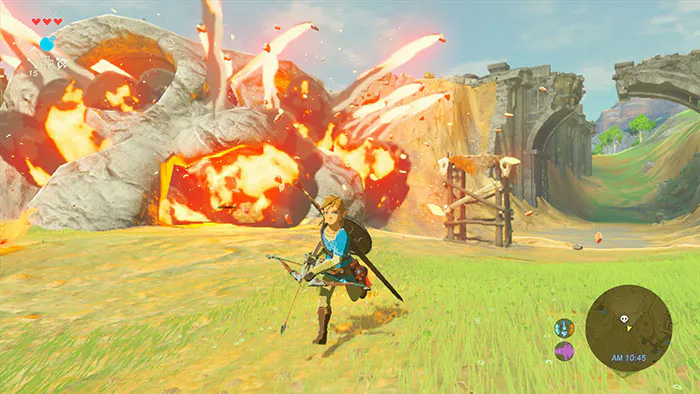
As I was saying, the game is voiced by actors, but only in certain parts. This is still a Japanese game, so most of it is told though text. The voiced over moments are a bit underwhelming – the actors did an adequate job, but that’s about it. Japanese actors did much better and thankfully it’s possible to change the voice language without changing the text. I’m not saying that the English voiceover is bad, just that it’s nice to have the freedom of choice. There are a couple of languages available – including Russian, for the first time ever. Nintendo really tried this time.
The game supports Amiibo – small interactive figurines, which have been selling like crazy since 2014. Chances are, you have one of those, and you’re in luck – every single one of those is supported. This is a first – I’ve never owned a game which supported all of them. Even Amiibo cards made specially for Animal Crossing games can be used. These Amiibos won’t give you much and you can use them once a day, but it’s still nice to get some pieces of food just like that. Special The Legend of Zelda: Breath of the Wild Amiibos have extended support, of course, with special features and sweet loot. They look cool as hell, too, which never hurts.
Well, it’s time to wrap things up. It’s obvious that The Legend of Zelda: Breath of the Wild is no ordinary game. It is a game which begs to speak about it, and I really don’t want to stop. While this game is special, I won’t say that it is perfect. Many features are aggravating – especially that damn rain that just won’t let me climb in peace. And still, there’s something there that separates this game from any other. Since buying it, not only I regularly play it, but also my wife, who rarely picks anything other than Animal Crossing. And yet, here she is – completely captivated with the game. It is a huge and spectacular piece of interactive entertainment – the one game we won’t forget anytime soon. Possibly, the best The Legend of Zelda game to date – perfect for both newbies and veterans. Both hard and fair, it allows to play at one’s own pace.
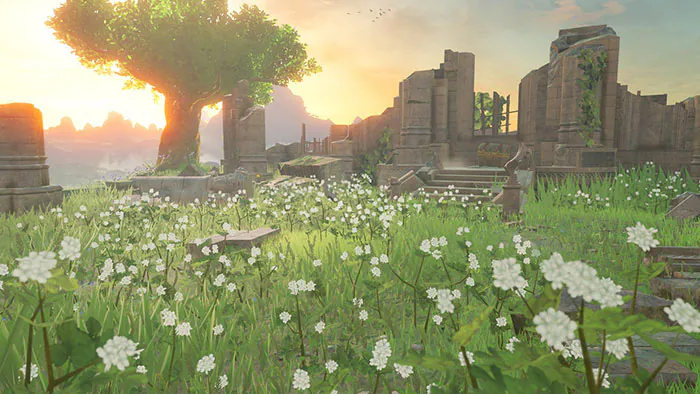
Let’s not forget about another important thing – the platform. Considering its size, it’s hard to forget that The Legend of Zelda: Breath of the Wild is completely portable. You can never turn it off, playing for a couple of minutes at a time. Play Zelda on a bus, plane or in the middle of nowhere with no Internet connection. There are different ways to play too: portable mode is great, but playing in front of a TV with Joy-Cons attached to a Joy-Con Grip is also very neat – the Grip is surprisingly comfortable. Those with additional funds can buy a Controller Pro, which allows for the most comfortable play imaginable.
The Legend of Zelda: Breath of the Wild is a spectacular game – one of the best Nintendo has ever made. There’s no better game to launch a new console and demonstrate its unique features. The Legend of Zelda: Breath of the Wild can be recommended to anyone. And if you already own a console, there’s just no excuse not to buy it.

